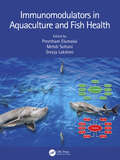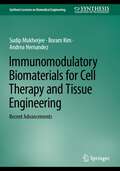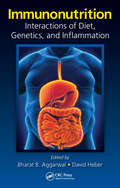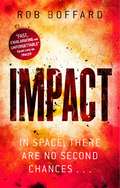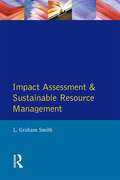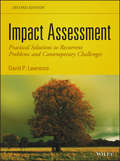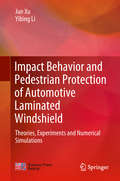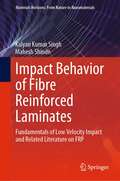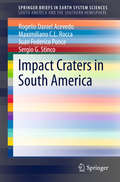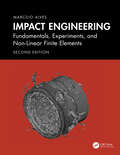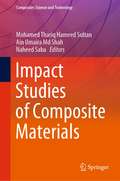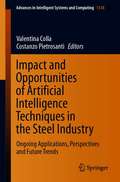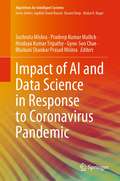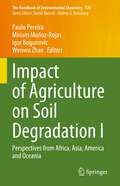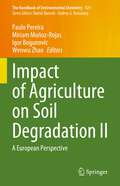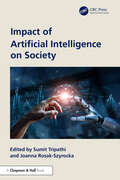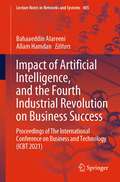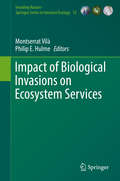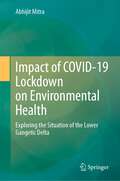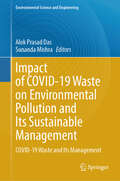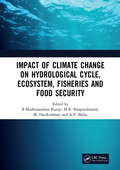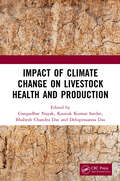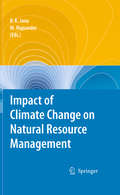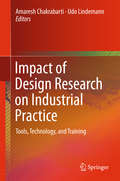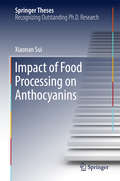- Table View
- List View
Immunomodulators in Aquaculture and Fish Health
by Preetham Elumalai Sreeja Lakshmi Mehdi SoltaniThis reference book provides updated information about different immunomodulators for managing fish health and sustainable aquaculture. Immunomodulators are dietary additives that enhance innate defense mechanisms and increase resistance against specific pathogens and diseases. The book covers the different types of immunostimulants, their modes of action, and their efficacies. It also reviews safety concerns, ethical regulations, limitations, and outreach to farmers. It discusses the application of herbal immunomodulators, antioxidants, pre- and pro-biotics, in disease management. Features:• Reviews the pressing topic of reduction of antibiotic use in aquaculture • Discusses herbal immunomodulators, nutrients, antioxidants and pre- and pro-biotics • Covers the topic of progressive immunomodulation using nanotechnology • Discusses fish health management in the ever-growing aquaculture industry • Includes natural and synthetic immunomodulators The book is meant for researchers and industry experts in aquaculture, fisheries science, and veterinary medicine.
Immunomodulatory Biomaterials for Cell Therapy and Tissue Engineering: Recent Advancements (Synthesis Lectures on Biomedical Engineering)
by Sudip Mukherjee Boram Kim Andrea HernandezThis book presents the recent developments in immunomodulatory biomaterials for cell-based therapies in various diseases, including diabetes, cancer, cardiovascular disease, and bone regeneration. The authors first cover the fundamentals of conventional immunology and immunomodulation, before focusing on the history, advantages, and challenges of cell therapies. Biological cell therapy has gained immense attention for various diseases due to unique advantages it has over chemical drugs regarding cost, ease of production, toxicity, and therapeutic efficacy. However, these cell-based therapies need an inert delivery system that can locally deliver cells and minimally elicit foreign body response. The book discusses the foreign body response to the immunomodulatory biomaterials as well as the current and future strategies for potential mitigation of considerable immune responses toward immunomodulatory biomaterials and devices.
Immunonutrition: Interactions of Diet, Genetics, and Inflammation
by David Heber Bharat B. AggarwalThe interaction of immune function and nutrition underlies the low-grade chronic inflammation involved in the etiology of many common obesity-associated and age-related chronic disease conditions. This close interaction is the genesis of the term immunonutrition, which represents a new interdisciplinary field of nutritional and medical research. Im
Impact (Outer Earth #3)
by Rob BoffardFollowing Tracer and Zero-G comes Impact, the explosive conclusion to the Outer Earth trilogy - a heart-pounding thriller set in space where the hero moves like lightning and the consequences for failure are deadly. A signal has been picked up from Earth. The planet was supposed to be uninhabitable. But it seems there are survivors down there - with supplies, shelter and running water. Perhaps there could be a future for humanity on Earth after all. Riley Hale will find out soon enough. She's stuck on a spaceship with the group of terrorists that is planning to brave the planet's atmosphere and crash-land on the surface. But when the re-entry goes wrong, Riley ends up hundreds of miles from her companions Prakesh and Carver, alone in a barren wilderness. She'll have to use everything she knows to survive. And all of them are about to find out that nothing on Earth is what it seems . . .
Impact Assessment and Sustainable Resource Management (Themes In Resource Management)
by L Graham SmithFirmly places impact assessment in the broader context of environmental planning, developing a much-needed integrative approach. The topics covered include: decision making and dispute resolution; the role of environmental law; public policy, administration and publication participation; the nature of planning; impact assessment methodology; the application of impact assessment to frontier developments; linear facilities and waste mana
Impact Assessment: Practical Solutions to Recurrent Problems and Contemporary Challenges
by David P. LawrenceOffers solutions and best practices to respond to recurrent problems and contemporary challenges in the field Since the publication of the first edition of Environmental Impact Assessment in 2003, both the practice and theory of impact assessment have changed substantially. Not only has the field been subject to a great deal of new regulations and guidelines, it has also evolved tremendously, with a greater emphasis on strategic environmental, sustainability, and human health impact assessments. Moreover, there is a greater call for impact assessments from a global perspective. This Second Edition, now titled Impact Assessment to reflect its broader scope and the breadth of these many changes, offers students and practitioners a current guide to today's impact assessment practice. Impact Assessment begins with an introduction and then a chapter reviewing conventional approaches to the field. Next, the book is organized around recurrent problems and contemporary challenges in impact assessment process design and management, enabling readers to quickly find the material they need to solve tough problems, including: How to make impact assessments more influential, rigorous, rational, substantive, practical, democratic, collaborative, ethical, and adaptive How each problem and challenge-reducing process would operate at the regulatory and applied levels How each problem can be approached for different impact assessment types—sustainability assessment, strategic environmental assessment, project-level EIA, social impact assessment, ecological impact assessment, and health impact assessment How to link and combine impact assessment processes to operate in situations with multiple overlapping problems, challenges, and impact assessment types How to connect and combine impact assessment processes Each chapter first addresses the topic with current theory and then demonstrates how that theory is applied, presenting requirements, guidelines, and best practices. Summaries at the end of each chapter provide a handy tool for structuring the design and evaluation of impact assessment processes and documents. Readers will find analyses and new case studies that address such issues as multi-jurisdictional impact assessment, climate change, cumulative effects assessment, follow-up, capacity building, interpreting significance, and the siting of major industrial and waste facilities. Reflecting current theory and standards of practice, Impact Assessment is appropriate for both students and practitioners in the field, enabling them to confidently respond to a myriad of new challenges in the field.
Impact Behavior and Pedestrian Protection of Automotive Laminated Windshield: Theories, Experiments And Numerical Simulations
by Jun Xu Yibing LiThis book addresses one of the most important components for pedestrian safety in vehicles – laminated windshields. It includes detailed real-world material characterization results for laminated glass and testing methodologies, constitutive models, and step-by-step numerical simulation modeling and simulation methods. As such, the book provides readers a thorough understanding of the mechanical behaviors of laminated glass and windshields. It also presents fundamental test data, analysis methodologies and essential insights into laminated glass safety design and mechanical behavior prediction. The book addresses the needs of researchers, engineers and postgraduate students in the fields of automotive engineering, mechanical engineering and related areas.
Impact Behavior of Fibre Reinforced Laminates: Fundamentals of Low Velocity Impact and Related Literature on FRP (Materials Horizons: From Nature to Nanomaterials)
by Kalyan Kumar Singh Mahesh Shinde^ This highly informative and carefully presented volume highlights the impact behavior of fibre reinforced polymer composites. It begins with a preliminary focus on FRP materials, fabrication processes, micro- and macro- mechanics to calculate FRP laminates properties, damage nodes associated with FRP composites under different loadings. It provides a simple and unified approach to cover aspects of FRP composites behavior with low velocity impact loading. This book offers a valuable guide for those who wish to develop deeper insights into weaving architectures, stacking sequences, fabrication processes, general damage modes associated with FRP composites. It is a useful volume for students, academia and industry alike.^
Impact Craters in South America
by Rogelio Daniel Acevedo Maximiliano C. L. Rocca Juan Federico Ponce Sergio G. StincoA complete and updated catalogue of impact craters and structures in South America from 2014 is presented here. Approximately eighty proven, suspected and disproven structures have been identified by several sources in this continent. All the impact sites of this large continent have been exhaustively reviewed: the proved ones, the possible ones and some very doubtful. Many sites remain without a clear geological "in situ" confirmation and some of them could be even rejected. Argentina and Brazil are leading the list containing almost everything detected. In Bolivia, Chile, Colombia, Guyana, Paraguay, Perú, Uruguay and Venezuela only a few were observed. Only Ecuador is waiting for new discoveries. So far, the largest well stated impact site is still the Araguainha structure in Brazil with its 40 kilometers in diameter. However, two possible impact structures are larger than Araguainha: Malvinas, (with 250 kilometers in diameter) and Vichada in Colombia, (50 kilometers). This study also reports the existence of some Tertiary-Quaternary glassy impactite layers: the "escorias" and "tierras cocidas" of the pampas in Argentina.
Impact Engineering: Fundamentals, Experiments, Nonlinear Finite Elements
by Marcílio AlvesThis second edition of Impact Engineering covers the dynamic analysis of structures undergoing small to large displacements, linear and nonlinear elastic material behavior to viscoplasticity, and the range of features of structural impact analysis.Individuals, as well as various governing bodies are concerned about protection against natural hazards, crash-type accidents, and terrorism- commonly referred to as "impact"- implying a rapid loading process. The book discusses the physics involved in such impact situations and incorporates analytical considerations as well as techniques to obtain and interpret experimental data and relevant numerical techniques. It also includes a chapter on scaling which is a relevant aspect when studying impact on large structures.This book will be useful for advanced students and professionals in civil and mechanical engineering as well as for students and researchers in applied physics and other relevant disciplines.
Impact Studies of Composite Materials (Composites Science and Technology)
by Naheed Saba Mohamed Thariq Hameed Sultan Ain Umaira Md ShahThis book discusses the impact of different range of velocities (low, high, ballistic and hyper-velocity impact) on composites. Presented through experimental and numerical analysis, the book goes beyond impact event analysis and also covers the after-impact phenomena, including flexural and compression and damage analysis through destructive and non-destructive evaluations. The analyses presented from either experimental or numerical simulations are composed of micro and macrographs images, illustrations, tables and figures with inclusive discussions and supportive evidences from recent studies on composites. This book also highlights the potential applications of composites through the lens of their impact properties, in different industries such as automotive and defence applications. Generally, this book benefits wider range of readers including the industrial practitioners, researchers, lecturer and students, who are working in the fields related to impact and damage analysis, including the structural health monitoring of composites, either experimentally or numerically.
Impact and Opportunities of Artificial Intelligence Techniques in the Steel Industry: Ongoing Applications, Perspectives and Future Trends (Advances in Intelligent Systems and Computing #1338)
by Valentina Colla Costanzo PietrosantiThis book collects perceptions and needs expectations and experiences concerning the application of Artificial Intelligence (AI) and Machine Learning in the steel sector. It contains a selection of themes discussed within the Workshop entitled “Impact and Opportunities of Artificial Intelligence in the Steel Industry” organized by the European Steel Technology Platform as an online event from October 15 until November 5, 2020. The event aimed at analyzing the diffusion of AI technologies in steelworks and at providing indications for future research, development and innovation actions addressing the sector demands. The chapters treat general analyses on transversal themes and applications for process optimization, product quality enhancement, yield increase, optimal exploitation of resources and smart data handling. The book is devoted to researchers and technicians in the steel or AI fields as well as for managers and policymakers exploring the opportunities provided by AI in industry.
Impact of AI and Data Science in Response to Coronavirus Pandemic (Algorithms for Intelligent Systems)
by Bhabani Shankar Prasad Mishra Pradeep Kumar Mallick Gyoo-Soo Chae Hrudaya Kumar Tripathy Sushruta MishraThe book presents advanced AI based technologies in dealing with COVID-19 outbreak and provides an in-depth analysis of variety of COVID-19 datasets throughout globe. It discusses recent artificial intelligence based algorithms and models for data analysis of COVID-19 symptoms and its possible remedies. It provides a unique opportunity to present the work on state-of-the-art of modern artificial intelligence tools and technologies to track and forecast COVID-19 cases. It indicates insights and viewpoints from scholars regarding risk and resilience analytics for policy making and operations of large-scale systems on this epidemic. A snapshot of the latest architectures, frameworks in machine learning and data science are also highlighted to gather and aggregate data records related to COVID-19 and to diagnose the virus. It delivers significant research outcomes and inspiring new real-world applications with respect to feasible AI based solutions in COVID-19 outbreak. In addition, it discusses strong preventive measures to control such pandemic.
Impact of Agriculture on Soil Degradation I: Perspectives from Africa, Asia, America and Oceania (The Handbook of Environmental Chemistry #120)
by Paulo Pereira Miriam Muñoz-Rojas Igor Bogunovic Wenwu ZhaoThis is the first of two volumes that together provide a global overview of the impact of agriculture on soil degradation, tracing the most critical drivers like the use and abuse of agrochemicals, mechanization, overgrazing, irrigation, slash and burn agriculture, and the use of plastics. This book covers the main effects of agriculture practices on soil degradation in several countries from Africa, America, Asia, and Oceania, and it elucidates the impact of chemical agents on soil quality, namely, the use of fertilizers, herbicides, pesticides, soil acidification and microplastics pollution. In these continents, a large number of the population depend on agriculture, which sets an enormous pressure on the ecosystems. Divided into 13 chapters, the book offers authoritative contributions about the fundamental soil degradation problems in countries such as Argentina, Australia, Peru and Bolivia, Brazil, Chile, China, Colombia, India, Israel, Kenya, Mexico, South Africa, the United States of America. As soil degradation issues are often linked with biodiversity loss and poverty, readers will also find in this book an important discussion of the different social, economic, political, and environmental aspects contributing to soil quality and sustainable management. Given the breadth and depth of its coverage, the book offers an invaluable source of information for researchers, students, environmental managers and policymakers alike.
Impact of Agriculture on Soil Degradation II: A European Perspective (The Handbook of Environmental Chemistry #121)
by Paulo Pereira Miriam Muñoz-Rojas Igor Bogunovic Wenwu ZhaoThis is the second of two volumes that together provide a global overview of the impact of agriculture on soil degradation, tracing the most critical drivers like the use and abuse of agrochemicals, mechanization, overgrazing, irrigation, slash and burn agriculture, and the use of plastics.Soil degradation caused by agriculture practices is a complex issue which depends on the interaction of social, economic, political, and environmental aspects. In this book, expert contributors elucidate the extension of the effects of agriculture on soil degradation in Europe, a continent with different cultures and political backgrounds that affect agricultural practices. Readers will also find in this book authoritative solutions to minimize the effects of agriculture intensification and land-use in this continent. Divided into 12 chapters, the book offers a European perspective on soil quality and sustainable management, including case studies about the impact of chemical agents like fertilizers, herbicides, pesticides, and soil acidification and microplastics pollution in agriculture practices from countries such as Croatia, Czech Republic, Estonia, Latvia and Lithuania, Germany, Portugal and Greece, Hungary, Iceland, Italy, Slovenia, Spain, Sweden, and Ukraine. Given the breadth and depth of its coverage, the book offers an invaluable source of information for researchers, students and environmental managers alike.
Impact of Artificial Intelligence on Society
by Joanna Rosak-Szyrocka Sumit TripathiThe book presents a comprehensive and interdisciplinary exploration of the impact of AI on various sectors of society to foster a greater understanding of the opportunities and challenges presented by this transformative technology. It explores the impact AI has had on varied sectors of society, including healthcare, education, the workplace, and the economy. It provides a holistic view of this fast-growing technology by critical study of the possible benefits and drawbacks linked with the application of AI in many industries. The book also examines the ethical, social, and economic implications of AI and the potential risks and challenges associated with its use. Focuses on the future influence of AI, providing insights into how it could disrupt several industries and change the way we live, work, and connect with one another Explores how AI can be used to tackle global issues such as climate change, food security, and public health concerns Offers case studies and specific examples of how artificial intelligence is being employed in many industries, covering both successes and failures Investigates cutting-edge technology breakthroughs in AI and how they can be used to improve efficiency, productivity, and performance across multiple industries Understands the limitations and potential biases of artificial intelligence, as well as the significance of human monitoring and accountability The book is intended for researchers, practitioners, policymakers, and students who are interested in understanding the nature and role of AI with regard to different sectors of society.
Impact of Artificial Intelligence, and the Fourth Industrial Revolution on Business Success: Proceedings of The International Conference on Business and Technology (ICBT 2021) (Lecture Notes in Networks and Systems #485)
by Allam Hamdan Bahaaeddin AlareeniThis book constitutes the refereed proceedings of the International Conference on Business and Technology (ICBT2021) organized by EuroMid Academy of Business & Technology (EMABT), held in Istanbul, between 06–07 November 2021. In response to the call for papers for ICBT2021, 485 papers were submitted for presentation and inclusion in the proceedings of the conference. After a careful blind refereeing process, 292 papers were selected for inclusion in the conference proceedings from forty countries. Each of these chapters was evaluated through an editorial board, and each chapter was passed through a double-blind peer-review process.The book highlights a range of topics in the fields of technology, entrepreneurship, business administration, accounting, and economics that can contribute to business development in countries, such as learning machines, artificial intelligence, big data, deep learning, game-based learning, management information system, accounting information system, knowledge management, entrepreneurship, and social enterprise, corporate social responsibility and sustainability, business policy and strategic management, international management and organizations, organizational behavior and HRM, operations management and logistics research, controversial issues in management and organizations, turnaround, corporate entrepreneurship, innovation, legal issues, business ethics, and firm gerial accounting and firm financial affairs, non-traditional research, and creative methodologies.These proceedings are reflecting quality research contributing theoretical and practical implications, for those who are wise to apply the technology within any business sector. It is our hope that the contribution of this book proceedings will be of the academic level which even decision-makers in the various economic and executive-level will get to appreciate.
Impact of Biological Invasions on Ecosystem Services
by Montserrat Vilà Philip E. HulmeThe book presents an analysis of the ecological, economic and social threats posed by the introduction and spread of non-native species. It provides a comprehensive description of impacts of non-native species from all five kingdoms of life across all ecosystems of the world. New insights into the impacts arising from biological invasions are generated through taking an ecosystem services perspective. This work highlights that management of biological invasions is needed not only to sustain biodiversity and the environment, but also to safeguard productive sectors such as agriculture, forestry and fisheries, as well as to preserve human health and well-being.
Impact of COVID-19 Lockdown on Environmental Health: Exploring the Situation of the Lower Gangetic Delta
by Abhijit MitraThis book examines the impacts that the COVID-19 lockdown has had on environmental and ecological health, with a focus on coastal ecosystems in the Lower Gangetic Delta. The book begins with an overview of COVID-19's spread and impact before and after the lockdown in the focus region, then addresses the specific impacts that the lockdown period had and continues to have on air quality, marine and estuarine water quality, coastal biodiversity, and the livelihoods of the region's inhabitants, especially those who live below the poverty line. The decrease in human activity combined with the complete closure of various sectors, including air travel, oil and gas drilling, and construction, has had a pronounced effect on biodiversity and overall environmental health that is yet to be fully realized. The book sheds light on these changes and assesses how biodiversity, ambient air quality, and ecosystem functioning will progress as COVID-19 remains a threat and the lockdown persists. The study will be of interest to researchers, government officials and professionals dealing with disaster management, environmental science, biological science, and health.
Impact of COVID-19 Waste on Environmental Pollution and Its Sustainable Management: COVID-19 Waste and Its Management (Environmental Science and Engineering)
by Alok Prasad Das Sunanda MishraThis book focuses on challenges that have arisen because of trash discharges and their potential causes and provides long-term sustainable solutions. Globally, the COVID-19 pandemic has caused immense devastation, leading to numerous fatalities as well as substantial economic losses and health issues. With the rise in COVID-19 cases, the amount of biomedical waste has multiplied, exposing more people to the epidemic. For developing countries, waste management is already a problem, and the waste generated during this pandemic situation has made things worse. If improper waste management techniques are not changed, the world will face a new crisis that could be referred to as a "garbage crisis." The increased quantity of COVID-19-associated waste (CAW) and their presence in the environment make them more vulnerable, potentially increasing the danger of food chain contamination. A few countries have already started putting emergency plans in place to address the “waste crisis.” Given the paucity of information on the mutational features and potential hosts of this newly discovered COVID-19, there is a pressing need for an effective plan to protect India's ecosystem against further contamination. To handle the current crisis and prevent the anticipated waste disaster, it is imperative to construct a more effective, automated, computerized, and well-modified waste management system during the COVID-19 period.
Impact of Climate Change on Hydrological Cycle, Ecosystem, Fisheries and Food Security
by B. Madhusoodana KurupClimate change has emerged as the most pressing global challenge of the 21st century and it has a dramatic effect on natural ecosystems and environment. Intelligent mitigation strategies to minimise climate change impacts can result in advanced, novel technologies; healthier aquatic ecosystems and higher food security and well-being for humans. The book includes 45 Chapters by expert authors, covering (i) Hydrometeorology and hydrology, (ii) Natural hazards and disaster risk management, (iii) Aquaculture, (iv) Changing biodiversity scenarios, (v) Capture fisheries, (vi) Food and nutritional insecurity, (vii) Climate change and socio-economic scenarios, and allied areas. It is hoped that this volume will further our understanding and research achievements in the field of climate change and its consequences and facilitate the synthesis of information on how climate-related changes will influence oceans, marine and inland ecosystems, hydrological cycles, fisheries and aquaculture and coastal communities and will be immensely useful to planners, scientists, conservationists, environmentalists, academicians, students and all those who are directly or indirectly involved in the study of impact of climate change and mitigation measures Note: T& F does not sell or distribute the Hardback in India, Pakistan, Nepal, Bhutan, Bangladesh and Sri Lanka.
Impact of Climate Change on Livestock Health and Production
by G D Nayak K K Sardar B C Das D P DasThis volume of 30 chapters contributed by reputed authors covers: Diversification of livestock and crops. Integration of livestock systems with forestry and crop production. Drought and heat wave tolerant varieties. Strategies for reduction of Green House Gases emission from ruminants. Application of GIS and remote sensing technologies. Breeds with inherent genetic capabilities to adapt to climate change. This book also takes into account the climate change adaptation, mitigation practices, and policy frameworks for promotion of sustainable livestock and poultry production. This book is co-published with NIPA. Taylor and Francis does not sell or distribute its print and electronic editions in India, Pakistan, Nepal, Bhutan, Bangladesh and Sri Lanka.
Impact of Climate Change on Natural Resource Management
by Mrinmoy Majumder Bipal Kr. JanaAs climate change takes hold, there is an ever-growing need to develop and apply strategies that optimize the use of natural resources, both on land and in water. This book covers a huge range of strategies that can be applied to various sectors, from forests to flood control. Its aim, as with resource management itself, is to combine economics, policy and science to help rehabilitate and preserve our natural resources. Beginning with papers on carbon sequestration, including the practice of artificial desertification, the topics move on to cover the use of distributed modeling and neural networks in estimating water availability and distribution. Further chapters look at uncertainty analysis applied to the spatial variation of hydrologic resources, and finally the book covers attempts at estimating meteorological parameters in the context of hydrological variables such as evapo-transpiration from stream flow. Within the next decade, the effects of climate change will be severe, and felt by ordinary human beings. This book proposes a raft of measures that can mitigate, if not reverse, the impact of global warming on the resources we have all come to depend on.
Impact of Design Research on Industrial Practice
by Amaresh Chakrabarti Udo LindemannShowcasing exemplars of how various aspects of design research were successfully transitioned into and influenced, design practice, this book features chapters written by eminent international researchers and practitioners from industry on the Impact of Design Research on Industrial Practice. Chapters written by internationally acclaimed researchers of design analyse the findings (guidelines, methods and tools), technologies/products and educational approaches that have been transferred as tools, technologies and people to transform industrial practice of engineering design, whilst the chapters that are written by industrial practitioners describe their experience of how various tools, technologies and training impacted design practice. The main benefit of this book, for educators, researchers and practitioners in (engineering) design, will be access to a comprehensive coverage of case studies of successful transfer of outcomes of design research into practice; as well as guidelines and platforms for successful transfer of research into practice.
Impact of Food Processing on Anthocyanins
by Xiaonan SuiThis thesis studies the impact of food processing on the stability and antioxidant capacity of anthocyanins in aqueous and real food systems. It investigates the effects of temperature and pH on the stability and antioxidant capacity of anthocyanins in aqueous systems and in real semi-solid and solid food systems including bread and biscuits. The results of this thesis offer food manufacturers valuable guidelines on the production of functional foods containing anthocyanins, helping to reduce anthocyanins loss and achieve a desired amount of anthocyanins in foods with extra health benefits.
